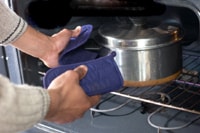Factors Affecting Safe Food Preparation by Food Workers and Managers
EHS-Net Recommends
These results can be used to guide future research in this area. For example, future research might focus on finding which factors have the greatest effect on food safety.
These results can guide restaurants in their attempts to improve food safety. For example, managers could review their practices and kitchens and find problems with food safety in their restaurants. They could also talk to food workers and find what problems stop them from handling food safely. Managers can then try to fix these problems.
Food-safety programs could try to better understand factors that affect food safety in restaurants in their areas. Then they could then try to help restaurants fix those factors.

Why This Study Was Done
Most foodborne illness outbreaks linked to restaurants are related to unsafe food handling by workers. Studies have shown that food workers often do not handle food safely. To improve worker practices, we need to know the factors that affect those practices.
What the Study Described
The purpose of this study was to describe the beliefs of workers and managers about what makes it easier or harder for them to do seven safe food-handling practices:
- Washing hands.
- Preventing contamination of food.
- Using gloves.
- Cooking food to the right temperature.
- Keeping heated food hot.
- Keeping cooled food cold.
- Reheating food to the right temperature.
What the Study Found
Workers identified many factors linked to each of the seven food-handling practices. Workers named some factors across several practices:
- Time pressure. Time pressure caused by high volume of business or poor staffing made it hard to do all seven safe food-handling practices.
- Equipment and resources. Equipment and resources were mentioned in discussion of all practices.
- Easy-access sinks and enough soap and gloves helped hand washing and glove use.
- Multiple color-coded cutting boards and separate work areas for different foods helped prevent the spread of germs.
- Multiple thermometers helped with proper holding, reheating, and cooling.
- Well-maintained equipment helped with proper holding, reheating, and cooling.
- Certain kinds of equipment helped with proper holding, reheating, and cooling.
- Not having enough workspace made it hard to do proper cooling and holding.
- Management and coworkers. Workers said they were more likely to safely handle food when managers and coworkers stressed food safety.
- Negative consequences. Workers were more likely to safely handle food when they knew that not doing so would lead to negative consequences.
- Food-safety education and training. Education and training are important to food safety. Several workers said it was also important to teach workers why they should engage in safe food practices.
- Restaurant procedures. Restaurant procedures helped food safety. These include recording when workers wash their hands and take food temperatures.
Scientific article this plain language summary is based on: Factors Impacting Food Workers’ and Managers’ Safe Food Preparation Practices: A Qualitative Study [PDF – 288 KB]
Other summaries related to hand hygiene:
- Food Worker Handwashing and Food Preparation
- Food Worker Handwashing and Restaurant Factors
- Food Safety Practices of Restaurant Workers
Food Workers’ Food Preparation Practices Focus Group Study (study information)
More EHS-Net publications by Study Topic
This study was conducted by the Environmental Health Specialists Network (EHS-Net). EHS-Net is a federally funded collaboration of federal, state, and local environmental health specialists and epidemiologists working to better understand the environmental causes of foodborne illness.